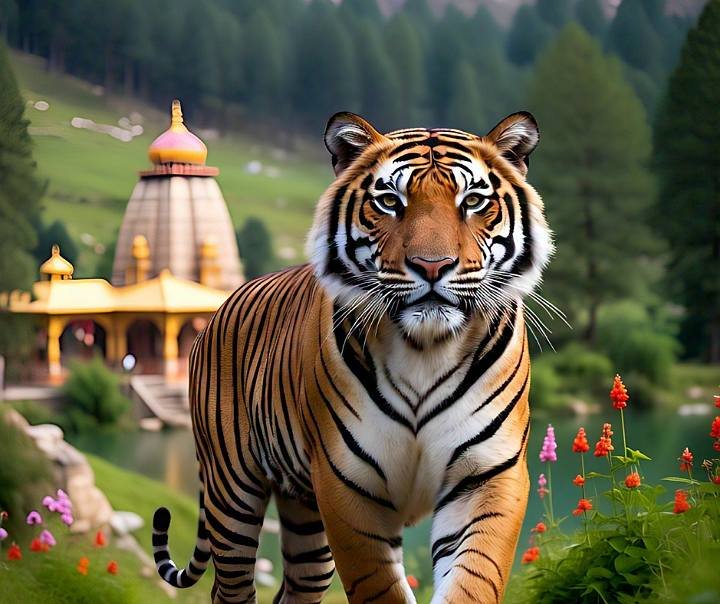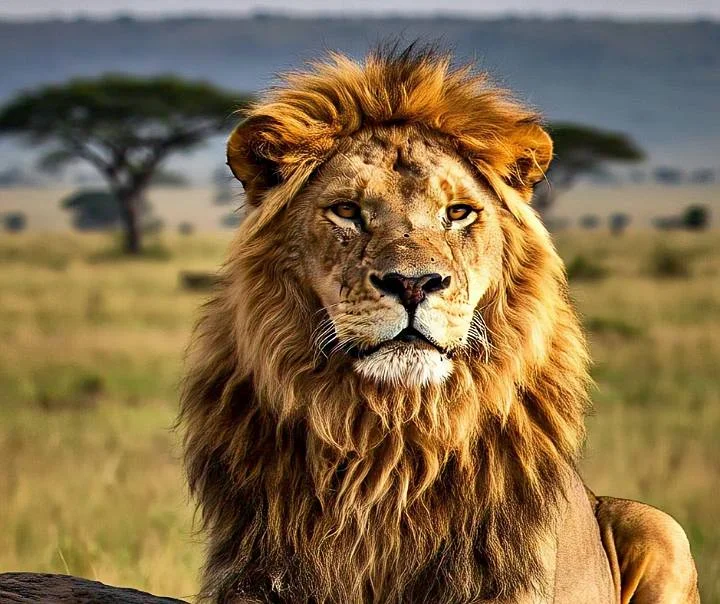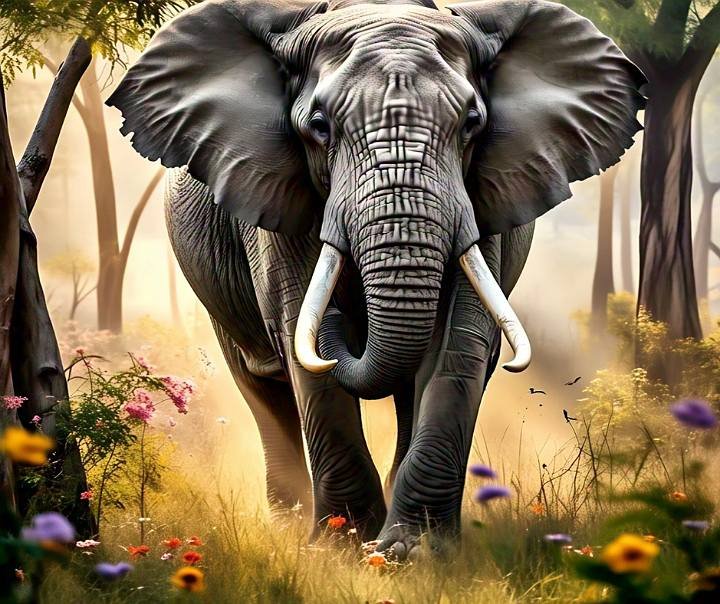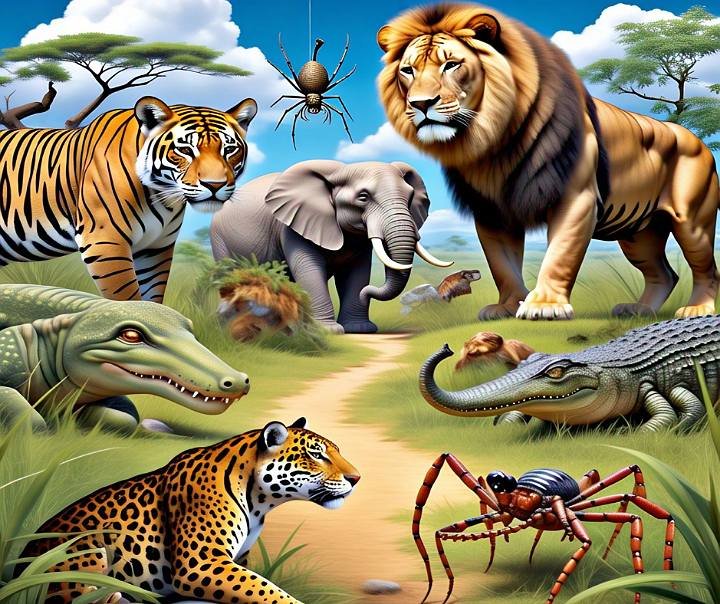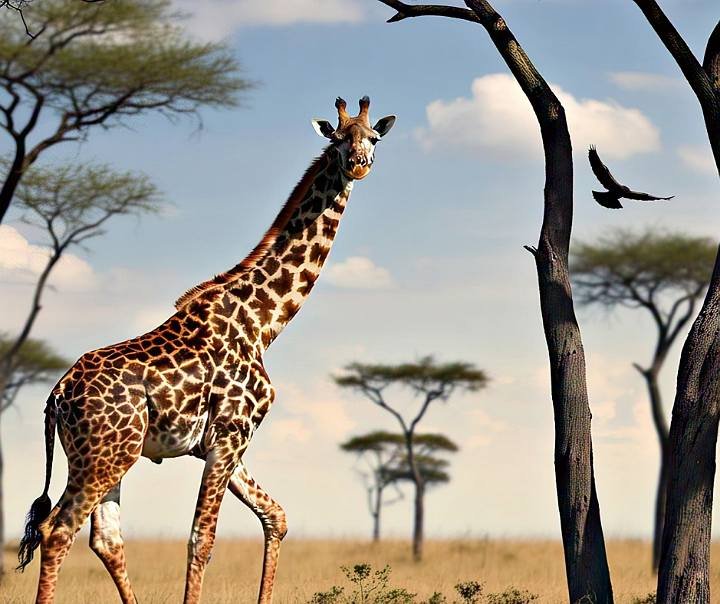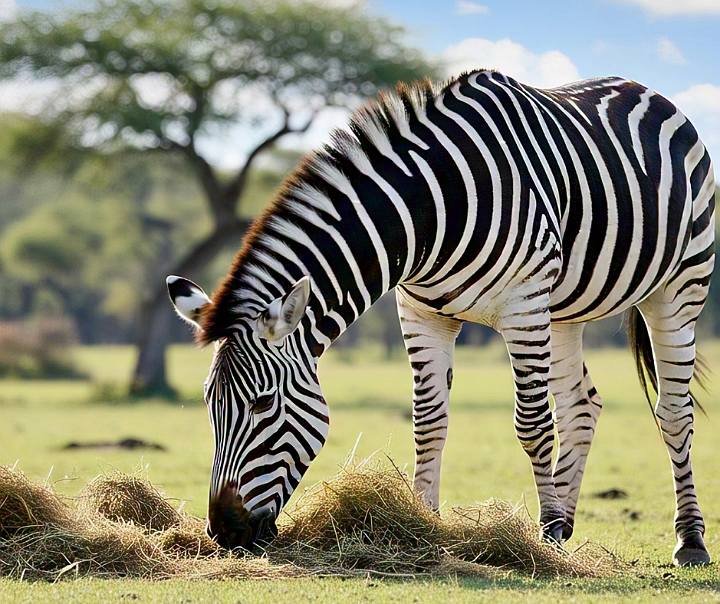Gorilla – The Peaceful Kings of the Jungle and the Mysteries of Their Lives
Hello, my dear friends! Imagine you’re wandering in a dense, green jungle, where the air is a mix of tropical humidity and freshness. Sunrays filter through the canopy of leaves, and suddenly, amid the rustling of foliage, a massive shadow appears – black, shiny skin, long-strong arms, broad chest, and eyes with a deep, intelligent sparkle. Yes, these are gorilla!
Friends, in this post today, we’ll have a long, in-depth chat about gorillas, just like we’re all sitting together sipping tea and sharing jungle stories. We’ll uncover every aspect from their types to habitats, eating-drinking habits, way of living, reproduction process, and conservation challenges. So, sit back comfortably, put your phone aside, and let’s embark on this exciting journey.
Gorilla Infobox
Category | Information |
|---|---|
Scientific Name | Gorilla (Genus) |
Classification | Great Ape (Hominidae Family) |
Native To | Central Africa (dense forests) |
Species | Two species: Western Gorilla (G. gorilla) and Eastern Gorilla (G. beringei) |
Diet | Herbivore (Folivore/Frugivore); primarily leaves, stems, fruit, and sometimes insects. |
Weight | Males (Silverbacks): Up to 270 kg (600 lb) Females: Up to 113 kg (250 lb) |
Height | Up to 1.8 meters (6 feet) tall (standing) |
Social Structure | Troops (groups) led by a dominant Silverback male. |
Key Behaviour | Use tools in the wild (rarely); known for “chest-beating” displays. |
Lifespan | Up to 35-40 years in the wild |
Conservation Status | All four subspecies are listed as either Endangered or Critically Endangered |
Abouts Gorilla
Did you know that gorillas are one of our closest relatives? Yes, after chimpanzees and bonobos, they are 98% genetically similar to humans! Read more about their close relations on the WWF website: WWF Gorilla Page. They remind us how connected and mysterious nature is.
Friends, gorillas belong to the primate family and are the largest living primates in the world. Scientifically, they fall under the Gorilla genus and are classified in the “great apes” category. They are often called “peaceful giants” because they look scary – strong jaws, long canine teeth, and massive size – but by nature, they are extremely calm, non-violent, and family-loving.
A adult male gorilla can be 5.6 to 6 feet (about 1.7-1.8 meters) tall when standing upright, and weigh 300 to 485 pounds (135-220 kg). Females are smaller, weighing around 150-250 pounds. They are so powerful that they can lift up to 800 kg with one hand, but they use their strength only to protect the family or gather food – never for aggression. If we talk about their evolution, gorillas evolved about 8-10 million years ago in Africa itself.
They walk on all fours (quadrupedal), but in danger, they stand up and adopt a boxing-like posture. You’ll be amazed by these unique habits on the National Geographic site: National Geographic Gorilla Facts. Think about it, friends, how intelligent they are – they can learn sign language and even solve simple problems! Now, let’s look at their various aspects under separate headings. This post will be so detailed that you’ll feel like you’re on a jungle tour.
Gorilla Types
Friends, first let’s talk about the types of gorillas. The gorilla world is a treasure trove of diversity, reminding us of nature’s creativity. According to scientific classification, the gorilla genus is divided into two main species: Eastern Gorilla (Gorilla beringei) and Western Gorilla (Gorilla gorilla).
Each species has two subspecies, differing based on their habitat, size, fur texture, and habits. In total, there are four main subspecies, and sometimes a fifth is recognized, but according to IUCN reports up to 2025, four are standard. Check the detailed classification on Wikipedia: Gorilla Wikipedia.
Let’s take them one by one. First, the Eastern Gorilla (Gorilla beringei). These are found in the high-altitude areas of East Africa, where the jungles are cool and misty. They have two subspecies:

1. Mountain Gorilla (Gorilla beringei beringei)
Friends, these are the most famous and iconic gorillas! They’re called “mountain gorillas” because they live in high mountains. Their skin is thick, protecting from cold, and long, black or blue-black fur provides warmth in cool weather. Silver-gray fur grows on their back, giving them a regal look. Weight up to 220 kg, height 1.65-1.75 meters.
They inhabit the Virunga Mountains and Bwindi Impenetrable Forest. According to the New England Primate Conservancy report, their fur is long and thick, distinguishing them from other gorillas. They are peaceful but brave in protecting their family. Think, friends, how adaptable they are – they even find fruits and flowers in cold jungles!
2. Eastern Lowland or Grauer’s Gorilla (Gorilla beringei graueri):
These are the largest gorillas, weighing up to 430 pounds (195 kg)! They’re also called “Grauer’s gorilla.” Found in the lowland jungles of the Democratic Republic of Congo, where the jungles are dense and humid. Their fur is shorter, and they’re slightly slimmer than mountain gorillas.
Unfortunately, their numbers are the lowest – only around 3,000-6,000. They live in the lower parts of the jungle, climbing big trees to pick fruits. See their pictures on the Gorilla World site: Gorilla Species. Friends, these types teach us how diversity strengthens the ecosystem – each has its own role, like Grauer’s gorillas being experts at seed dispersal.
Now, the Western Gorilla (Gorilla gorilla). These live in the lower jungles of West and Central Africa, where the weather is hot and humid. They have two subspecies:
- Western Lowland Gorilla (Gorilla gorilla gorilla): The most common subspecies, once numbering in the lakhs in the Congo Basin, but now endangered. Their fur is short and thin, skin shiny black. Weight 135-220 kg, and they love fruits. According to Animal Diversity Web, they have a small mouth and prominent eyebrows on their face. They roam in swampy jungles and eat insects too.
- Cross River Gorilla (Gorilla gorilla diehli): The rarest! Only 200-300 left, on the Nigeria-Cameroon border. They’re small-sized (weight 80-100 kg) and shy. Their habitat is in river valleys, where they hide and live. WWF reports say they’re stocky, with broad chests and human-like hands. Friends, this rarity warns us – if we don’t act, they’ll disappear.
Overall, these gorilla types represent Africa’s biodiversity. According to Britannica’s 2025 entry, they are our closest relatives. Each type has its own story – the adventure of mountains, the vastness of Grauer’s, the playfulness of lowlands, and the mystery of Cross River.
Think, friends, how empty the jungle would be without them! In this section, we’ve seen how nature has given them different forms to fit every environment. Let’s move on to habitats.
Gorilla Habitat
Friends, now let’s talk about the gorillas’ home – their habitat. Gorillas are mainly found in the tropical rainforests, mountain jungles, and swampy areas of Central and West Africa. These areas span from 650 meters to 4,500 meters above sea level, hiding treasures of biodiversity.
According to Gorilla.org reports, wild gorillas are found in 10 African countries: Angola, Cameroon, Central African Republic, Republic of Congo, Democratic Republic of Congo, Equatorial Guinea, Gabon, Nigeria, Rwanda, and Uganda. But the distribution is limited – eastern gorillas in DRC, Rwanda, and Uganda, while western from Guinea to Congo.
In detail: Mountain gorillas live in the Virunga Mountains, on the border of Rwanda, Uganda, and DRC. Areas like Bwindi Impenetrable National Park (Uganda) and Volcanoes National Park (Rwanda), at altitudes of 2,500-4,000 meters. These jungles are full of bamboo, herbs, and mist.
The African Wildlife Foundation says they are spread across four national parks – Bwindi, Mgahinga, Virunga, and Sarengheti. Friends, imagine – volcanic soil nourishes these jungles, making gorillas strong, but political instability poses a threat.
Grauer gorillas inhabit eastern lowlands of DRC, in dense jungles like Ituri Forest. Altitude is lower (500-1,500 meters), and jungles are cut by rivers. Western lowland gorillas in the vast rainforests of the Congo Basin – Gabon, Congo, and Cameroon. They prefer swampy areas where fruits are abundant. See the map on See the Wild: Gorilla Habitat Map. These jungles are called the world’s lungs, but logging is shrinking them.
Cross River gorillas in Cross River National Park on the Nigeria-Cameroon border, in river valleys and hilly jungles. Altitude 1,000-2,000 meters, and jungles scattered in small patches. Gorilla SP reports that eastern gorillas are limited to three countries. Friends, these habitats are not just homes for gorillas but the foundation of the entire ecosystem.
Climate change is altering rain patterns, reducing fruits. Read on Berggorilla.org how much space gorillas need – a group requires 20-30 square kilometers! List of African countries with gorillas: African Countries with Gorillas. These jungles give us oxygen, but human expansion has shrunk them by 50%. Think, if these homes are gone, where will gorillas go? This section reminds us of environmental conservation.
Gorilla’s Eating and Drinking
Now, friends, let’s talk about the gorillas’ stomach – their eating and drinking! Gorillas are mainly herbivores, but western lowlands sometimes eat insects. Their diet is based on over 200 plants: fruits (67%), leaves, stems, seeds, roots, bark, and bamboo. An adult eats 18-20 kg (40 pounds) daily, necessary for their massive body. See diet details on SeaWorld: Seaworld Gorilla Diet.
In detail: Fruits and leaves are main. Mountain gorillas depend on bamboo stems and herbs, while lowlands prefer fruits – over 100 types, like figs and African peaches. According to Africa Safari’s 2025 report, fruits are sweet and calorie-rich, providing energy.
When fruits are scarce, leaves and bark increase. Insects and fungi – western gorillas eat termites, ants, and mushrooms for protein. Ovacado Adventures says they are selective foragers – only fresh parts, like the pith of leaves.
Foraging behavior: Half the day is spent searching for food. Mornings chewing grass and leaves, afternoons fruits. The silverback leads the group. PMC study says leaves increase when fruits are low. Zoo diets feed 115 items. HowStuffWorks’ 2025 post says they are muscular herbivores because fiber-rich diet strengthens digestion.
Friends, think – how are they so strong without hunting? Because nature gave them a balanced diet. National Zoo: Western Lowland Gorilla Diet. They disperse seeds, reviving the jungle. For drinking, rivers and dew. This section shows how gorillas are part of nature’s cycle.
Gorilla’s Way of Living
Hey friends, now let’s come to the gorillas’ everyday life – meaning how they live, play, and care for each other. Think, they’re just like our family! Gorillas don’t roam alone; they live in groups of 5 to 30, which we call troops. Sometimes up to 50. According to WWF, their 98.3% DNA matches ours, so they laugh, get sad, everything the same.
First, who’s the boss of the group? The silverback – that big male gorilla with silver-gray fur on his back. This boss takes care of everyone – finding food, protecting from danger, making decisions. There are 3-4 females, and kids follow his cues.
But the fun part is that everyone in the group is equal, less fights. They love grooming – cleaning each other’s fur, which strengthens bonds. Inside Bwindi report says adult females are unrelated but compete to stay near the silverback. On Wikipedia, the silverback is the heart of the group. Gorilla.org says most groups are 5-10, but sometimes larger.
Now see the daily routine – they wake up at sunrise, head out for food, walk 9-10 km. In the afternoon, tired, they rest by making nests. National Zoo says active morning-evening, nap in afternoon. Sleep 9-10 hours at night, building nests on trees with fresh leaves.
Kids play and jump all day, adults hug or playfully push sometimes. Cambridge study says their society is complex, kids learn foraging. Rwanda Eco says one silverback and many females in troops.
Berggorilla says young blackbacks roam alone. Gorilla Fund says they’re non-aggressive, peaceful. Friends, in danger, they warn by chest-beating – that famous chest beating! Sometimes use tools, like sticks to extract insects. See Denver Zoo: Western Lowland Gorilla. Seeing all this, it feels like gorillas’ life is more fun than ours – no stress, just with family. They teach us how to maintain relationships, care, and stay together even in grief.
Gorilla’s Reproduction
Friends, now let’s talk about how gorillas expand their family – meaning reproduction. They do it slowly, just like us humans, no hurry. Female gorillas are ready to have babies at 10-12 years old, and males at 11-13. Rwanda Eco says one baby every 4 years, and pregnancy is only 8.5 months. Gorilla World says females mature at 7-8 years, but first baby at 10-12.
Berggorilla report is that births happen in breeding groups. Silverback mates with females, but it can happen year-round, depending on ovulation. Silverback Tours says the mating cycle starts from this. Study.com says females one every 4 years, but males with multiple. WWF says only one baby at a time, and stays with mom for 3-4 years. Volcanoes site says females start ovulating at 8 years. SeaWorld says females transfer at 8 years. The baby is only 4 pounds at birth and clings to mom.
Life cycle – breastfed for 3 years from birth, then weaning. Young become independent at 8-10 years. In family, silverback acts like a father in care, mom carries the baby in her lap while roaming. Friends, seeing this, it feels like gorillas’ family is super strong – no rush, just love and patience. This cycle teaches us how to maintain stability in life and prepare the next generation.
Gorilla Conservation
Friends, now let’s talk about gorilla conservation – meaning how they’re being saved. This part is a bit sad, but also full of hope. Imagine, these strong and peaceful animals are in danger, but the good news is that humans like us can help them.
First, know their status. There’s a big organization called International Union for Conservation of Nature (IUCN) that monitors the status of world animals. It’s called the IUCN Red List, which tells which animal is in danger. As of 2025, mountain gorillas’ status is “endangered” (in danger), better than previous “critically endangered” (severely in danger).
This is good news because it was downgraded in 2018. But western lowland gorillas are still “critically endangered,” meaning very serious threat. Overall, gorilla numbers are declining – once in lakhs, now only a few thousand left. Only around 1,063 mountain gorillas.
Now, see what threats they face. The biggest is jungle cutting – people clear forests for wood or farming. This is shrinking gorillas’ home. Second, illegal hunting – some people kill them for meat (bushmeat) or sell hands-feet, which are useless things.
Third, diseases like Ebola, which spread from humans. Fourth, climate change – weather changes reduce rain, fruits decrease, and jungles dry up. All this together troubles gorillas. For example, mining and logging in Congo Basin have destroyed over 50% of their homes.
But friends, don’t lose hope! Many organizations like WWF, IUCN, and Gorilla Fund are working together. The good thing is eco-tourism is helping – meaning people go to jungles to see gorillas, ticket money goes to protect parks. In Rwanda and Uganda, this method is amazing, locals left hunting to become guides.
Then, patrols increased – rangers set gates in jungles, catch poachers. Vaccination is happening to prevent Ebola. Community programs explain to villagers that killing gorillas is wrong, and saving jungles benefits everyone. In 2025, good news came that mountain gorilla numbers slightly increased, and Rwanda’s model is praised worldwide. Read more on IFAW website: Gorilla Threats.
So, friends, what can we do? Easiest – spread awareness, share on social media. Donate to WWF or Gorilla Fund. Use less plastic, because it reaches jungles. If opportunity comes, go gorilla trekking – but responsibly. Remember, gorillas teach us how to maintain nature’s balance. If we all try together, these kings of the jungle will be strong again!
Interesting Facts
Friends, now comes the most fun part – interesting facts about gorillas! These facts will not only make you laugh but also make you ponder nature’s wonders. We’ve selected them in detail so you can understand gorillas even closer. Let’s look at 15 unique facts:
- World’s Largest Primate: Gorillas are the largest among all primates. An adult male silverback can be as tall as an average human (about 1.7 meters) and weigh over 200 kg. They’re bigger than chimpanzees or orangutans!
- Double Species: There are two main species of gorillas – eastern and western. Eastern ones live in hilly areas, while western in dense rainforests. Each has its own subspecies, making them unique.
- Group Life: Gorillas don’t live alone; they stay in families of 5-30 members. The silverback is the leader who cares for everyone. These groups have strong bonding like human families.
- Scary but Peaceful: Look scary, but gorillas are peaceful. They avoid fights and only warn by chest-beating in danger. Actually, they fear violence more!
- Super Strong Bite: A mountain gorilla’s bite force is double that of a lion! They break hard bamboo with strong jaws, but don’t use for hunting.
- 98% DNA Match: We share 98% genetic material with humans. So, gorillas laugh, grieve, and even use tools!
- Nose Print Unique: Every gorilla’s nose print is different, like our fingerprints. Scientists identify them by this. No two gorillas have the same nose!
- Silverback Weight: Adult silverback (male) is the heaviest primate – up to 400 pounds! But they use strength only for family protection.
- Long Life: 35-50 years in wild, but up to 50-60 in captivity. Human care extends their life.
- Tool User: Gorillas make umbrellas from leaves or extract termites with sticks. Proof of intelligence!
- Sleeping Nest: Every night they build nests from fresh leaves to sleep. The nest is strong enough for the whole family to rest comfortably.
- Family Oriented: Silverbacks care for kids like fathers. They’re shy and gentle, but do anything for family.
- Small Range: Mountain gorillas live in only two separate groups, far from each other. Shows their limited spread.
- Herbivore Diet: They eat up to 30 kg plants a day, but never meat. Western ones eat some insects for protein.
- Intelligent Leader: Silverbacks lead the group intelligently – finding food, avoiding danger. They’re true family men!
Friends, these facts make gorillas so special! See more facts on National Geographic Kids site: 10 Great Gorilla Facts.
Common Questions About Gorillas (FAQ)
Now, friends, many people ask common questions about gorillas. Here are some common FAQs, taken from WWF, IFAW, and other sources. These will resolve your confusions:
- How many gorillas are there in total?
As of 2025, mountain gorillas number about 1,063, living in two separate groups. Total gorillas have dropped below 300,000. - Are gorillas dangerous?
No, gorillas are peaceful. They fear humans and attack only if family is threatened. Avoid misconceptions like King Kong – they’re gentle giants! - What do gorillas eat?
Mainly herbivores – leaves, fruits, bamboo, and roots. Western lowlands eat some insects too. Up to 18-30 kg a day! - Is gorilla trekking safe?
Yes, but with a guide. Gorilla trekking happens in protected areas, and following rules means no danger. According to IGCP, it’s safe. - What are the main threats to gorillas?
Habitat loss, illegal hunting, diseases like Ebola, and climate change. Human activities are the biggest threat. - How similar are gorillas to humans?
Share 98.3% DNA. So, their behavior is human-like – emotions, social bonds. - How long do gorillas live?
35-50 years in wild, 50-60 in captivity. Good care makes it longer. - What do gorillas fear?
Reptiles like chameleons and caterpillars! They get scared of some things like humans.
If you have more questions, ask in comments! See WWF’s FAQ site: WWF Gorilla Facts.
Lessons from Gorillas
So, my friends, today we’ve explored the life of gorillas up close. They’re not just kings of the jungle but teach us peace, family importance, intelligence, and conservation. In the next post, we’ll wander into the chimpanzee world. Any questions or your jungle story? Share in comments! Keep reading such fun talks on junglejhadi.com, and promise to save nature.
Read more –
